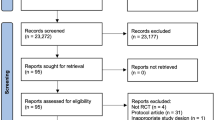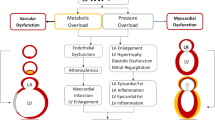Abstract
Purpose
Although high-intensity interval aerobic training (HIT) effectively improves aerobic fitness, the risk of cardiac arrest transiently increases during strenuous physical exertion in patients with cardiovascular disease. For safety and efficacy concerns, this investigation explored the effect of a modified HIT (mHIT) on exertional ventilatory-hemodynamic efficiency in heart failure patients with reduced ejection fraction (HFREF).
Methods
HFREF patients were prospectively assigned to two groups: mHIT and usual healthcare (UC). The former comprised supervised continuous aerobic training at ventilatory anaerobic threshold for 50 min/day, 3 days/week for 4 weeks, and then 3-min intervals at 40 and 80 % VO2 reserve for 50 min/day, 3 days/week for 8 weeks. The latter received optimal medical treatment only. Ventilatory and hemodynamic responses during exercise were measured before and after the intervention. Paired-t and repeated measures ANOVA with post hoc tests were adopted.
Results
Each group had an N of 33. The mHIT and UC group had matched baseline characteristics including health-promotion concept and behavior score. The mHIT for 12 weeks (1) increased VO2, cardiac output, and notably, cardiac power output at peak workload (1,151 ± 573 vs. 1,306 ± 596 L/min/mmHg); (2) reduced V E/VO2 (32.4 ± 4.6 vs. 30.0 ± 4.0), breathing frequency, ventilation, and enhanced stroke volume compliance at identical submaximal intensity (50 % peak workload at pre-intervention evaluation). No significant changes in ventilatory and hemodynamic responses to exercise were observed following the UC.
Conclusions
The mHIT regimen improves peak cardiac pumping capacity with reducing cardiac after-load and simultaneously increases ventilation efficiency during exercise in patients with HFREF. Thereby, aerobic fitness is ameliorated.

Similar content being viewed by others
Abbreviations
- 50 %pre W peak :
-
Workload at the 50 % of the peak during the pre-training evaluation
- BF:
-
Breathing frequency
- CO:
-
Cardiac output
- CPET:
-
Cardiopulmonary exercise test
- CPO:
-
Cardiac power output
- DavO2 :
-
Arterio-venous O2 difference
- HIT:
-
High-intensity aerobic interval training
- HR:
-
Heart rate
- HRQOL:
-
Health-related quality of life
- mHIT:
-
Modified high-intensity aerobic interval training
- MAP:
-
Mean arterial pressure
- MCT:
-
Moderate continuous training
- OUES:
-
Oxygen uptake efficiency slope
- PVC:
-
Peripheral vascular conductance
- RPP:
-
Rate-pressure product
- HFREF:
-
Heart failure with reduced ejection fracture
- SV:
-
Stroke volume
- SVC:
-
Stroke volume compliance
- UC:
-
Usual care
- VAT:
-
Ventilatory anaerobic threshold
- V E :
-
Minute ventilation
Reference
Antoine-Jonville S, Pichon A, Vazir A, Polkey MI, Dayer MJ (2012) Oxygen uptake efficiency slope, aerobic fitness, and V E–VCO2 slope in heart failure. Med Sci Sports Exerc 44:428–434
Balady GJ, Arena R, Sietsema K, Myers J, Coke L, Fletcher GF, Forman D, Franklin B, Guazzi M, Gulati M, Keteyian SJ, Lavie CJ, Macko R, Mancini D, Milani RV (2010) Clinician’s Guide to cardiopulmonary exercise testing in adults: a scientific statement from the American Heart Association. Circulation 122:191–225
Cattadori G, Schmid JP, Brugger N, Gondoni E, Palermo P, Agostoni P (2011) Hemodynamic effects of exercise training in heart failure. J Card Fail 17:916–922
Chemla D, Hebert JL, Coirault C, Zamani K, Suard I, Colin P, Lecarpentier Y (1998) Total arterial compliance estimated by stroke volume-to-aortic pulse pressure ratio in humans. Am J Physiol 274:H500–H505
Clark AL, Cleland JG (2005) Beta-blockers, exercise, and ventilation in chronic heart failure. J Card Fail 11:340–342
Davey P, Meyer T, Coats A, Adamopoulos S, Casadei B, Conway J, Sleight P (1992) Ventilation in chronic heart failure: effects of physical training. Br Heart J 68:473–477
Fu TC, Wang CH, Hsu CC, Cherng WJ, Huang SC, Wang JS (2011) Suppression of cerebral hemodynamics is associated with reduced functional capacity in patients with heart failure. Am J Physiol Heart Circ Physiol 300:H1545–H1555
Fu TC, Wang CH, Lin PS, Hsu CC, Cherng WJ, Huang SC, Liu MH, Chiang CL, Wang JS (2013) Aerobic interval training improves oxygen uptake efficiency by enhancing cerebral and muscular hemodynamics in patients with heart failure. Int J Cardiol 167:41–50
Gademan MG, Swenne CA, Verwey HF, van de Vooren H, Haest JC, van Exel HJ, Lucas CM, Cleuren GV, Schalij MJ, van der Wall EE (2008) Exercise training increases oxygen uptake efficiency slope in chronic heart failure. Eur J Cardiovasc Prev Rehabil 15:140–144
Gielen S, Schuler G, Adams V (2010) Cardiovascular effects of exercise training: molecular mechanisms. Circulation 122:1221–1238
Hambrecht R, Fiehn E, Weigl C, Gielen S, Hamann C, Kaiser R, Yu J, Adams V, Niebauer J, Schuler G (1988) Regular physical exercise corrects endothelial dysfunction and improves exercise capacity in patients with chronic heart failure. Circulation 98:2709–2715
Hambrecht R, Gielen S, Linke A, Fiehn E, Yu J, Walther C, Schoene N, Schuler G (2000) Effects of exercise training on left ventricular function and peripheral resistance in patients with chronic heart failure: a randomized trial. JAMA 283:3095–3101
Haykowsky MJ, Liang Y, Pechter D, Jones LW, McAlister FA, Clark AM (2007) A meta-analysis of the effect of exercise training on left ventricular remodeling in heart failure patients: the benefit depends on the type of training performed. J Am Coll Cardiol 49:2329–2336
Haykowsky MJ, Timmons MP, Kruger C, McNeely M, Taylor DA, Clark AM (2013) Meta-analysis of aerobic interval training on exercise capacity and systolic function in patients with heart failure and reduced ejection fractions. Am J Cardiol 111:1466–1469
Jakovljevic DG, Donovan G, Nunan D, McDonagh S, Trenell MI, Grocott-Mason R, Brodie DA (2010) The effect of aerobic versus resistance exercise training on peak cardiac power output and physical functional capacity in patients with chronic heart failure. Int J Cardiol 145:526–528
Jakovljevic DG, Seferovic PM, Nunan D, Donovan G, Trenell MI, Grocott-Mason R, Brodie DA (2012) Reproducibility of cardiac power output and other cardiopulmonary exercise indices in patients with chronic heart failure. Clin Sci 122:175–181
Jessup M, Abraham WT, Casey DE, Feldman AM, Francis GS, Ganiats TG, Konstam MA, Mancini DM, Rahko PS, Silver MA, Stevenson LW, Yancy CW (2009) 2009 focused update ACCF/AHA guidelines for the diagnosis and management of heart failure in adults: a report of the American College of Cardiology Foundation/American Heart Association Task Force on Practice Guidelines: developed in collaboration with the International Society for Heart and Lung Transplantation. Circulation 119:e1977–e2016
Keren H, Burkhoff D, Squara P (2007) Evaluation of a noninvasive continuous cardiac output monitoring system based on thoracic bioreactance. Am J Physiol Heart Circ Physiol 293:H583–H589
Lang CC, Karlin P, Haythe J, Lim TK, Mancini DM (2009) Peak cardiac power output, measured noninvasively, is a powerful predictor of outcome in chronic heart failure. Circ Heart Fail 2:33–38
Maurer MM, Burkhoff D, Maybaum S, Franco V, Vittorio TJ, Williams P, White L, Kamalakkannan G, Myers J, Mancini DM (2009) A multicenter study of noninvasive cardiac output by bioreactance during symptom-limited exercise. J Card Fail 15:689–699
Mittleman MA, Maclure M, Tofler GH, Sherwood JB, Goldberg RJ, Muller JE (1993) Triggering of acute myocardial infarction by heavy physical exertion. Protection against triggering by regular exertion. N Engl J Med 329:1677–1683
Myers J, Gujja P, Neelagaru S, Burkhoff D (2007) Cardiac output and cardiopulmonary responses to exercise in heart failure: application of a new bio-reactance device. J Card Fail 13:629–636
O’Connor CM, Whellan DJ, Lee KL, Keteyian SJ, Cooper LS, Ellis SJ, Leifer ES, Kraus WE, Kitzman DW, Blumenthal JA, Rendall DS, Miller NH, Fleg JL, Schulman KA, McKelvie RS, Zannad F, Piña IL (2009) Efficacy and safety of exercise training in patients with chronic heart failure: HF-ACTION randomized controlled trial. JAMA 301:1439–1450
Pinkstaff S, Peberdy MA, Kontos MC, Finucane S, Arena R (2010) Quantifying exertion level during exercise stress testing using percentage of age-predicted maximal heart rate, rate pressure product, and perceived exertion. Mayo Clin Proc 85:1095–1100
Rognmo Ø, Moholdt T, Bakken H, Hole T, Mølstad P, Myhr NE, Grimsmo J, Wisløff U (2012) Cardiovascular risk of high- versus moderate-intensity aerobic exercise in coronary heart disease patients. Circulation 126:1436–1440
Rosenblum H, Helmke S, Williams P, Teruya S, Jones M, Burkhoff D, Mancini D, Maurer MS (2010) Peak cardiac power measured noninvasively with a bioreactance technique is a predictor of adverse outcomes in patients with advanced heart failure. Congest Heart Fail 16:254–258
Tan LB (1986) Cardiac pumping capability and prognosis in heart failure. Lancet 2:1360–1363
Thompson PD, Riebe D, Pescatello LS (2013) ACSM’s guidelines for exercise testing and prescription, 9th edn. Lippincott Williams & Wilkins, Philadelphia, pp 240–246
Van Laethem C, Van De Veire N, De Backer G, Bihija S, Seghers T, Cambier D, Vanderheyden M, Sutter JD (2007) Response of the oxygen uptake efficiency slope to exercise training in patients with chronic heart failure. Eur J Heart Fail 9:625–629
Wasserman K, Whipp BJ, Koyl SN, Beaver WL (1973) Anaerobic threshold and respiratory gas exchange during exercise. J Appl Physiol 35:236–243
Williams SG, Jackson M, Cooke GA, Barker D, Patwala A, Wright DJ, Albuoaini K, Tan LB (2005) How do different indicators of cardiac pump function impact upon the long-term prognosis of patients with chronic heart failure? Am Heart J 150:983
Wisloff U, Stoylen A, Loennechen JP, Bruvold M, Rognmo Ø, Haram PM, Tjønna AE, Helgerud J, Slørdahl SA, Lee SJ, Videm V, Bye A, Smith GL, Najjar SM, Ellingsen Ø, Skjaerpe T (2007) Superior cardiovascular effect of aerobic interval training versus moderate continuous training in heart failure patients: a randomized study. Circulation 115:3086–3094
Acknowledgments
The authors would like to thank the Chang Gung Medical Research Program (Grant number CMRPG 391201-3) for the financial support. Support from the staff of the Cardiac Rehabilitation Center in Chang Gung Memorial Hospital during the assessment and exercise training sessions is acknowledged and appreciated.
Conflict of interest
There are no potential conflict of interest regarding this study, including relationships with medical device companies or other corporations whose products or services are related to the subject matter of the article.
Author information
Authors and Affiliations
Corresponding author
Additional information
Communicated by Keith Phillip George.
Rights and permissions
About this article
Cite this article
Huang, SC., Wong, MK., Lin, PJ. et al. Modified high-intensity interval training increases peak cardiac power output in patients with heart failure. Eur J Appl Physiol 114, 1853–1862 (2014). https://doi.org/10.1007/s00421-014-2913-y
Received:
Accepted:
Published:
Issue Date:
DOI: https://doi.org/10.1007/s00421-014-2913-y




